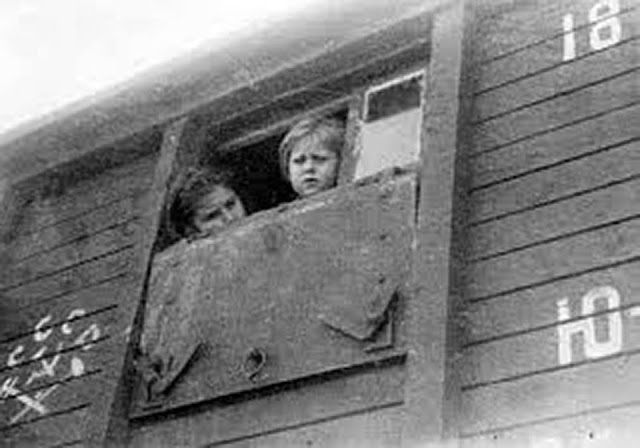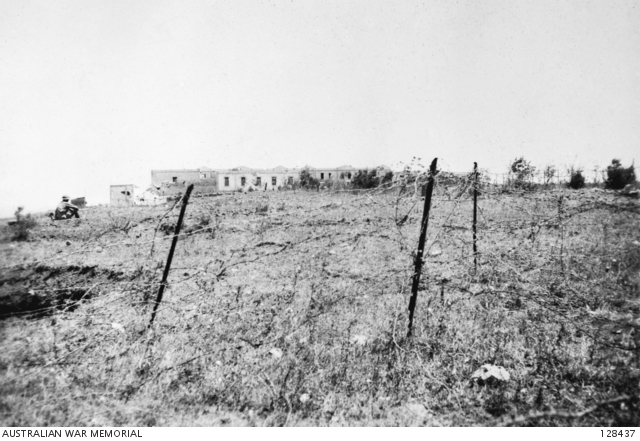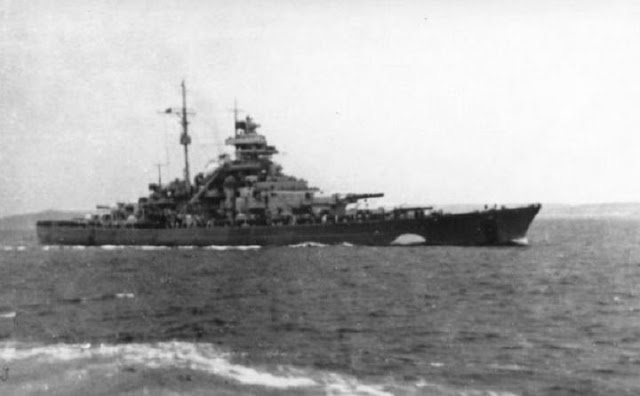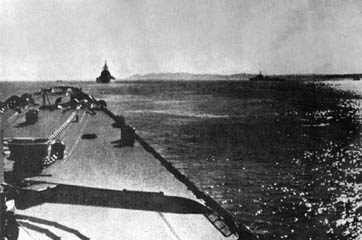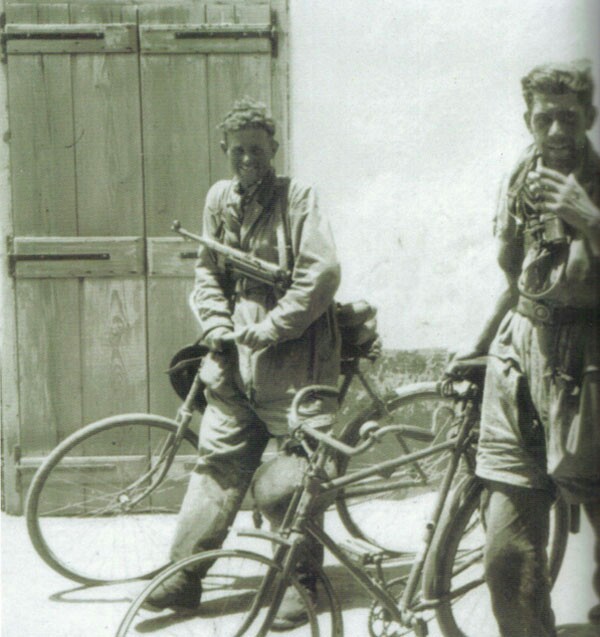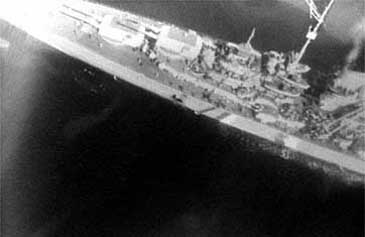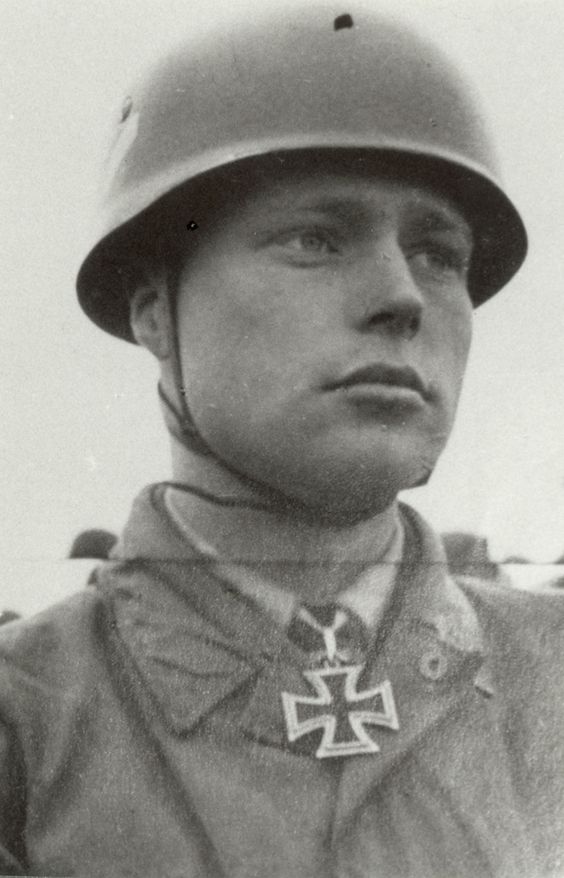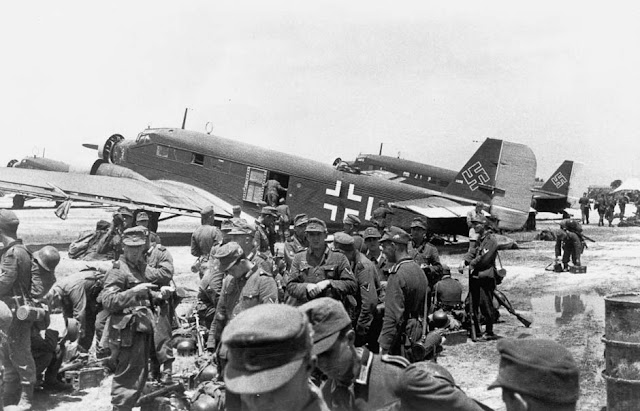Friday 20 June 1941
 |
| "Fortress Mark I, AN521 WP-K, of No. 90 Squadron RAF based at West Raynham, Norfolk, preparing for takeoff at Hatfield, Hertfordshire, during an inspection of newly-arrived American aircraft by the Chief of the Air Staff and the US Air Attache." 20 June 1941. © IWM (CH 2873). |
Brigadier Wilfrid Lewis Lloyd, now back in command of the 5th Indian Infantry Brigade after temporarily being in command of Genforce (now under the command of Major-General John Evetts), makes his best effort to relieve his encircled troops. He sends two companies from the 3/1st Punjab Regiment, two companies of French Marines and a battery of artillery to open a corridor to Mezzeh. The Vichy French, however, fight hard and slow the relief column, and the relief troops (the 2/3rd Battalion and 2/5th Field Regiment) get no help from the flanks.
The Indian troops, with no food or water and having run out of ammunition, surrender at 13:30, a hugely embarrassing blow for the British command. This goes a long way to restoring Gallic pride on the Vichy side and, somewhat perversely, leaves them more open to the idea of eventual surrender.
However, the hard fighting around Damascus continues. The Australian relief column continues fighting forward and retakes Mezzeh at 19:00. However, now it is an empty city and of little tactical significance beyond being one of many road junctions. The battle around Damascus now degenerates into a classic melee in which both sides jostle for control of the roads and hills (which hold forts) overlooking those roads, with neither side in control as the day ends.
The Vichy Government decides to ramp up peace feelers to Great Britain. It gives up trying to use the American Consul-General to broker a deal, and instead, Premier Petain covertly sends a representative directly to London. This is fairly easily done via Lisbon.
Luftwaffe General Hellmuth Felmy, the commander of Special Staff F (Sonderstab F), the Luftwaffe's mission to Iraq, is reassigned. The entire idea of the Axis intervening in Iraq has now drifted completely out of the realm of possibility, so Felmy becomes commander of Army Group Southern Greece (Befehlshaber Südgriechenland). In any event, in these commands, he never has to leave Athens and never has any real responsibility - the reassignment is simply an admission of the ridiculousness of continuing with the fiction of an Axis presence in Iraq.
European Air Operations: During the day, RAF Bomber Command sends 11 aircraft on anti-shipping missions. After dark, RAF Bomber Command bombs Kiel with 115 bombers during the night.
 |
| Soviet cruiser Komintern, based at the Black Sea base at Sevastopol. |
U-123 (Kptlt. Karl-Heinz Moehle), on its fifth patrol out of Lorient and operating near the Azores, uses gunfire and torpedoes and sinks 4333-ton Portuguese freighter Ganda. There are five deaths and 61 survivors. As the ship sinks, Moehle notices that the ship flies a neutral flag. Upon his return to Lorient, Moehle reports the matter, and U-boat headquarters (BdU) tells him to alter the log to make the sinking appear legal.
The Luftwaffe bombs and sinks 2249-ton Norwegian freighter Schieland, which is sailing with Convoy FS.520, southeast of Grimsby. There is one death (who dies later) and eight survivors.
The Luftwaffe bombs and sinks Royal Navy 258-ton minesweeping trawler HMT Resmilo at Peterhead. Everyone survives (no casualties).
The Luftwaffe bombs and damages 5578-ton British tanker Inverarder off the Isle of Wight. The master beaches the tanker at Motherbank Buoy, Solent. It later is refloated and repaired at Southampton.
The Luftwaffe bombs and damages 2841-ton freighter Cormount off Outer Dowsing Light Vessel. There is one death.
British 2844-ton freighter Ilse hits a mine and is damaged near Hartlepool. There is one death. The forepart is flown off, but the rear portion of the ship is towed to Middleborough and repaired.
Royal Navy minelayer Teviotbank lays minefield BS.64 in the North Sea.
Convoy OB-337 departs from Liverpool, Convoy HX-134 departs from Halifax, Convoy SC-35 departs from Sidney bound for the Clyde.
Royal Navy escort carrier HMS Audacity (Commander Douglas W. MacKendrick) and minelayer Manxman are commissioned, corvette Campion is launched, and destroyer Relentless is laid down.
U-351 (Oblt. Karl Hause) is commissioned, U-506 is launched.
 |
| A mortar officer and rangefinder operator of the Lovat Scouts, during an exercise in the Faroe Islands, 20 June 1941. |
Italian submarine Ondina torpedoes and sinks 3805-ton Turkish liner Refah forty miles south of Mersin. There are 165-167 deaths.
Italian 4543-ton freighter Buccari explodes under mysterious circumstances at Taranto, Apulia, Italy.
Two Royal Navy submarined, HMS Tetrarch and Severn, make unsuccessful attacks on ships, the former off Lemnos, the latter off Palermo.
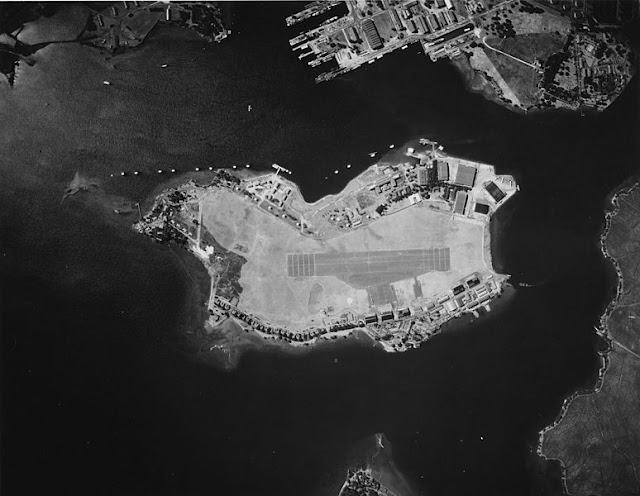 |
| Overhead view of Ford Island, Pearl Harbor, Territory of Hawaii, in June 1941. |
Sleeper Soviet spy Richard Sorge, posing as a journalist in Tokyo, has sent many warnings to Moscow about Operation Barbarossa. Today, he tries again, drafting a final warning:
[German Ambassador to Japan] Ott told me that war between Germany and the USSR is inevitable…. Invest [the code name for Japanese journalist Hotsumi Ozaki] told me that the Japanese General Staff is already discussing what position to take in the event of war.Sorge gives the message to his crony, Max Clausen, for transmission, but for pragmatic reasons, it is not sent until 21 June.
The Japanese protest at the opening of the luggage of Japanese Minister Yoshiaki Miura by Pan American Airways employees in Guatemala. Diplomat Sadao Iguchi goes to the office of the Chief of the Far Eastern Section in Washington and requests that the airline be told the proper handling of diplomats' baggage, i.e., not to search them. The reason the Japanese are so concerned with this issue at this time is that they have come into possession of detailed maps of the Panama Canal Zone from Italians living there and wish to transport them to Tokyo. There, the maps could be used for planning military attacks.
 |
| The last billet of the German 506 Infantry Regiment, 291st Infantry Division, before the Russian campaign, June 20, 1941. |
While long on rhetoric - and it is very strong rhetoric indeed - the statement is short on proposals for action. He notes somewhat lamely that "Full reparation for the losses and damages suffered by American nationals will be expected from the German Government," though he does not say how he expects to receive such reparations. Roosevelt concludes that the Reich seeks to make the United States "submit," but "We are not yielding and we do not propose to yield."
The President does not, of course, mention that Robin Moore was carrying war supplies to the British. However, to be fair to Roosevelt, the Robin Moore was sunk outside of the blockade zone set up by the Reich around Great Britain and the attack thus was illegal despite renewed warnings by the Germans in May about the dangers on the high seas. So, both sides have some facts with which to justify their positions, but all that matters, for the time being, is whether the United States is going to declare war over the affair - and it isn't.
There are rumblings about the US/German relationships on the other side of the Atlantic, too. At 21:00, Hitler's adjutant Colonel Rudolf Schmundt tells Hitler that Admiral Raeder has just told him that a U-boat captain claimed to have attempted to sink US battleship USS Texas about 10 miles within the blockade zone - but failed. Raeder has justified the attempted sinking, which almost certainly would have created an opportunity for President Roosevelt to declare war on the Reich. This disturbs Hitler, who wants nothing to do with the United States while he is focusing on the Soviet Union. He spends the night considering whether new rules are in order regarding attacks on US shipping.
 |
| "Calm Before the Storm." Soviet border guards on the western border, 20 June 1941. |
 |
| USS O-9 (SS-70), which foundered 20 June 1941. The wreck site was found in 1997 by Klein Sonar but the location remains a secret known only to the US Navy. |
Arnold becomes Chief of the Army Air Forces and acting "Deputy Chief of Staff for Air" with authority over both the Air Corps and Air Force Combat Command (successor to GHQAF). Arnold would prefer that the air force become a separate branch of the military equal to the Army and Navy, but Chief of Staff George C. Marshall (an old friend from before World War I) convinces Arnold to wait until after the brewing war for complete separation.
US Navy Task Group 2.6, led by the aircraft carrier USS Wasp (CV-7), departs from Hampton Roads, Virginia on a neutrality patrol.
Three US Navy submarines conduct deep submergence tests about 15 miles (24 km) off Portsmouth, New Hampshire. These tests go very badly when USS O-9 (SS-70) implodes and kills its 34 crewmen. There is nothing that can be done, it is a great tragedy that receives surprisingly little publicity and is not long remembered.
 |
| A sign in the General Government area of occupied Poland that says "Generalgouvernment of the Occupied Polish area - border 14 meters." This is at the Granitza River, and beyond in the area of Poland occupied by the Soviet Union. 20 June 1041 (Federal Archive Bild 169-0897) |
Issued in secret, the four-page document includes a lengthy recitation of the warped view of recent history that characterizes his speeches. The Proclamation also includes some specious claims (such as that there were no German troops on the border "until a very few weeks ago" when in fact he has been planning Operation Barbarossa for almost a full year). It is overkill for an "Order of the Day" and reads as an attempted justification for his attack, which he claims has been forced upon him by the Jewish-Bolshevik rulers of Moscow. In other words, it is simply more of the same rationalizations and prevarications that characterize all of his justifications for war.
The Proclamation ends:
At this moment, soldiers of the eastern front, an assembly of strength the like of which in size and scale the world has never seen is now complete. In league with Finnish divisions, our comrades are standing with the Victor of Narvik [Dietl] on the shores of the Arctic in the north. German soldiers under the command of the Conquerer of Norway [Falkenhorst], and the Finnish heroes of freedom under their own Marshal [Mannerheim] are protecting Finland. On the eastern front stand you. In Romania, on the banks of the Prut, and along the Danube right down to the beaches of the Black Sea are German and Romanian troops united under Antonescu, the head of state. When this, the biggest front line in history, now begins its advance it does so not just to provide the means of ending for all time this great war, or to defend those countries currently concerned, but for the salvation of our entire European civilization and culture.
German soldiers! You are thus entering upon a harsh and demanding fight—because the fate of Europe, the future of the German Reich, the existence of our nation now rest on your hands alone.
May the Lord God help us all in this struggle.Hitler confirms with OKW operations chief General Alfred Jodl that Operation Barbarossa will begin on 22 June.
The troops themselves, meanwhile, are told that an attack on the Soviet Union is "hypothetical" and everything related to such an attack is an "exercise." This makes sense to the troops - why attack the Soviet Union when the Reich is still at war with England?
The Kriegsmarine, meanwhile, now is laying mines in the Baltic. U-boats there have orders to shoot at any Soviet ships (there are none). All Soviet ships in Reich ports are prevented from leaving under one pretext or another.
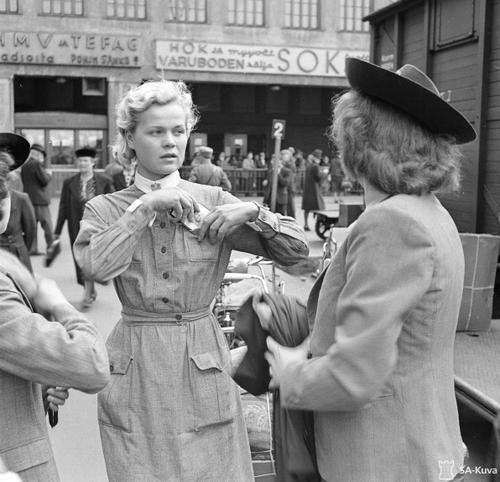 |
| A member of the Finnish voluntary auxiliary paramilitary organization for women (Lotta Svärd) in Helsinki prepares to head to the front on 20 June 1941. |
Soviet Military: The Red Air Force has issued orders to camouflage airfields, but these measures require time to prepare and have not yet been begun. It also forms the 6th Fighter Corps in Moscow for the protection of the capital. An air raid drill over Moscow is planned for Sunday, 22 June.
German Government: During the day, Adolf Hitler tells his secretaries that he just finds something "wrong" about Russia - it reminds him of the ghost ship in "The Flying Dutchman." He explains:
Because we know absolutely nothing about Russia. It might be one big soap-bubble, but it might just as well turn out to be very different.This will be a recurrent theme throughout World War II - how little the Reich knows about Russia.
Hitler is confident about Operation Barbarossa but also concerned. In his diary entry today, adjutant Hewel writes that Hitler:
told me that this morning [June 20] he again pored over every minute detail, but found no possibility for the enemy to get the better of Germany. He thinks Britain will have to give in - and he hopes it will be before the year is over.Hewel also writes that Hitler admits there "must always be a big element of risk." Among Hitler's worries are secret weapons, fanatical Soviet resistance, and the unknown.
Hitler needs to take pills to get to sleep. This is the beginning stage of his growing reliance on medicines for normal functioning.
"Racial theorist" Alfred Rosenberg delivers a speech in which he states that the sole use of the conquered peoples in Eastern Europe is to feed German troops and citizens. Their own survival is not a priority. This is a refrain that will recur from various German leaders throughout the war.
Norway: The Norwegian occupation authorities finally force actors and directors to end their theater strike that began on 21 May. The strike has been a major public relations failure for the Germans, receiving publicity in Swiss publications. The strike leaves very hard feelings in the occupation authorities, and the German Ministry of Culture takes full control of Norwegian Theaters. Many prominent theatrical figures are arrested at the Grini concentration camp for the remainder of the war. The strike ultimately has a devastating effect on the Norwegian theatrical scene, as the public decides to boycott shows to show solidarity and puts many theater workers out of work.
 |
| "Reflections of Spring" by Peter Mork Monsted. |
Soviet Homefront: In a case of odd timing, Soviet anthropologists Mikhail M. Gerasimov, Lev V. Oshanin and V. Ia. Zezenkova open the tomb of the Ruler of the Golden Horde, Timur (also known as Tamerlane). His tomb in Samarkand reportedly is inscribed with the words:
When I rise from the dead, the world shall tremble.Inside the casket reportedly is another inscription:
Whomsoever opens my tomb shall unleash an invader more terrible than I.The locals are sure that this violation of the tomb of Timur will lead to bad things - such as an invasion.
American Homefront: In a major win for US Unions, Ford Motor Company signs its first contract with the United Auto Workers (UAW) and Congress of Industrial Organizations (CIO).
Charles Lindbergh gives an isolationist speech in Los Angeles.
New York Yankee Joe DiMaggio continues his club-record hitting streak. He goes 4-5 against the Detroit Tigers in New York. DiMaggio now has hit safely in 33 games. While DiMaggio is setting history with his streak, his batting average remains far below that of Boston Red Sox player Ted Williams, who is en route to the last .400 season in MLB history.
RKO Radio Pictures releases Walt Disney Productions' "The Reluctant Dragon." An animated film, the film turns into a tour of the brand-new Walt Disney Studios building in Burbank, California. Radio comedian Robert Benchley walks the audience through the studio. After an introductory segment, the remainder of the film is in Technicolor, which in a world of black-and-white films is a draw in and of itself. The film does not, of course, mention the Disney animators' strike that still is in progress right outside the Burbank facility at the time of release. In fact, there is a ringer playing an animator in the studio, actor Alan Ladd.
The film roughly breaks even and does not alleviate the financial strain under which Disney Studios has been laboring since the failure of "Pinocchio." However, as with all Disney animated films, the characters live on in the Disney universe and make appearances in "Who Framed Roger Rabbit" (1988) and some other later productions.
Marx Brothers comedy "The Big Story" opens. Released by Metro-Goldwyn-Mayer, "The Big Store" features Margaret Dumont as the Marx Brothers' employer in a fight over control a department store. The film is billed as the act's farewell performance and generally is considered a lesser offering by the Marx Brothers. However, it does turn a profit and the Marx Brothers reunite in 1946 for "A Night In Casablanca."
 |
| Grave of NX25117 Nicholas George Koorey, 2/6 Field Regiment, who died of wounds in the Levant on 20 June 1941 (Australian War Memorial P12165.002). |
June 1, 1941: Farhud Pogrom
June 2, 1941: Massacres on Crete
June 3, 1941: Kandanos Massacre
June 4, 1941: Kaiser Wilhelm Passes Away
June 5, 1941: Death in Chungking
June 6, 1941: Hitler's Commissar Order
June 7, 1941: Commandos Strike at Pessac
June 8, 1941: British Invade Syria and Lebanon
June 9, 1941: Litani River Battle
June 10, 1941: British Take Assab
June 11, 1941: Hitler Thinking Beyond Russia
June 12, 1941: St. James Agreement
June 13, 1941: Lützow Damaged
June 14, 1941: Latvian June Deportations
June 15, 1941: Operation Battleaxe
June 16, 1941: The Old Lion
June 17, 1941: British Spanked in North Africa
June 18, 1941: Turkey Turns Its Back
June 19, 1941: Cheerios Introduced
June 20, 1941: Birth of US Army Air Force
June 21, 1941: Damascus Falls
June 22, 1941: Germany Invades Russia
June 23, 1941: A Soviet KV Tank Causes Havoc
June 24, 1941: Kaunas and Vilnius Fall
June 25, 1941: Finland Declares War
June 26, 1941: Bombing of Kassa
June 27, 1941: Encirclement At Minsk
June 28, 1941: Minsk Falls
June 29, 1941: Brest Fortress Falls
June 30, 1941: Mölders Becomes Top Ace


